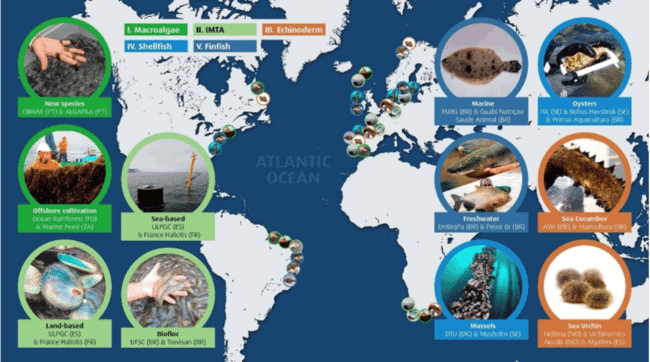Called AquaVitae, the new and innovative EU-funded project, will concentrate on five value chains: macroalgae, integrated multi-trophic aquaculture (IMTA), echinoderm species (such as sea urchins), shellfish and finfish.

At the show’s EU EATIP Day on 9 October the spotlight will be on new aquaculture value chains, especially those that include species from the lowest levels of the food chain. Philip James, project coordinator, will present AquaVitae’s ambitions and expected outcomes in the session, joining representatives of the European Commission, EATIP and sectoral stakeholders.
“The EATip session focusing on the importance of low trophic species is a tremendous opportunity to show case AquaVitae and its possible contribution to low trophic aquaculture value chains in the Atlantic,’’ says James.
Aquaculture Europe, which has brought around 2,500 delegates from 109 countries to Berlin this week, coincides with the kick-off of most of the project’s case studies. Eight representatives will participate in Aquaculture Europe, and will be available to talk about the environments, processes and species in their case studies.
The projects are as follows:
- Sea urchin roe enhancement, Philip James (Nofima, Norway)
- Offshore cultivation of macroalgae, Urd Grandorf Bak (Ocean Rainforest, Faroe Islands)
- Land-based IMTA, Gercende Courtois de Viçose (University Las Palmas de Gran Canaria, Spain)
- Biofloc and pond-based IMTA, Felipe Vieira (Univ. Fed. Santa Catarina, Brazil)
- Sea cucumber for IMTA application, Matthew Slater (AWI, Germany)
- Native and under-utilised oyster species in Brazil and Scandinavia, Colin Hannon (GMIT, Ireland)
- Freshwater aquaculture of piracuru and tambaqui, Lucas S. Torati (EmBraPa, Brazil)
- Marine aquaculture of Brazilian flounder, Luis Sampaio (Univ. Federal do Rio Grande, Brazil)
- Low trophic feeds for aquaculture, Sofia Engrola (CCMAR, Portugal)
The case study leaders have just started developing prototypes of the species that they want to produce, or the processes and/or production methods that they are studying. These will then be evaluated and assessed for environmental impact, socio-economic benefits and consumer safety and preference.
Some of the cross-cutting activities involve research into biosensors, internet of things (IoT), product characteristics, market potential, environmental monitoring, as well as analyses of value chains, and policy frameworks.


